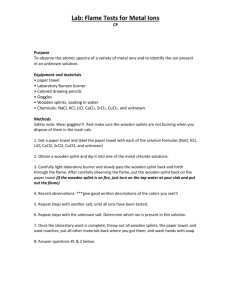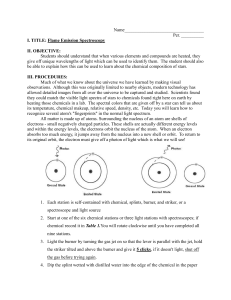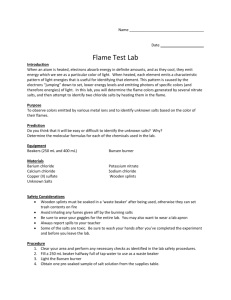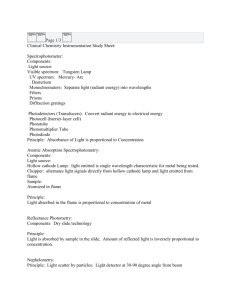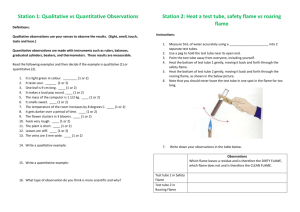Worksheet for Video #1 - Testing Gases: H2, O2, and CO2
advertisement
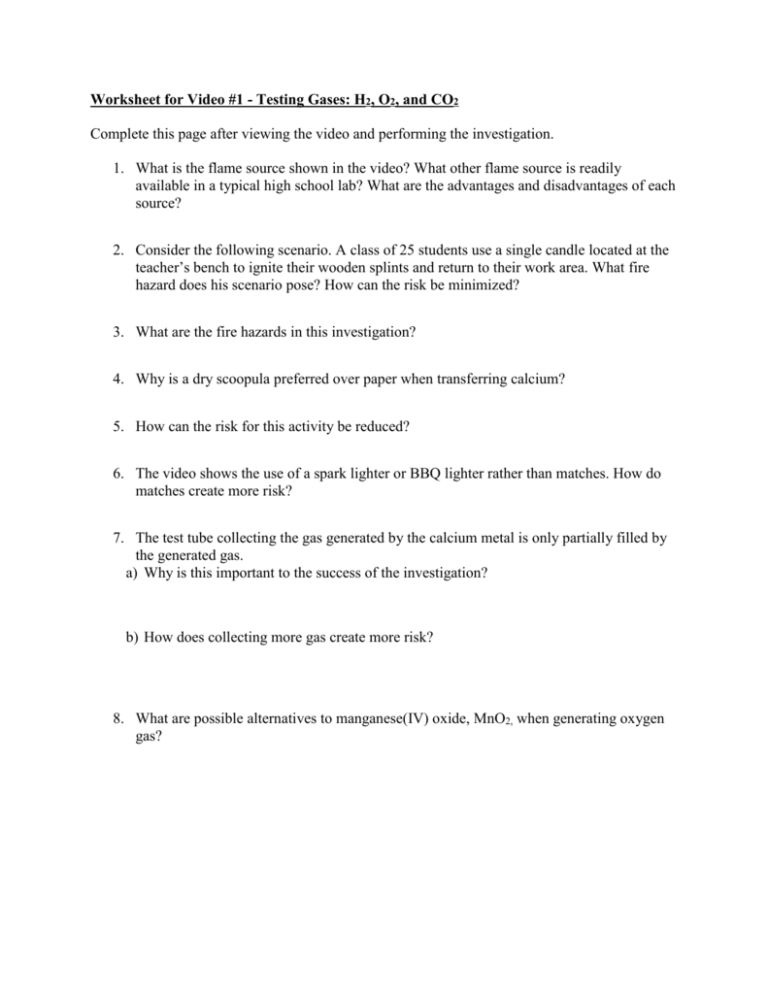
Worksheet for Video #1 - Testing Gases: H2, O2, and CO2 Complete this page after viewing the video and performing the investigation. 1. What is the flame source shown in the video? What other flame source is readily available in a typical high school lab? What are the advantages and disadvantages of each source? 2. Consider the following scenario. A class of 25 students use a single candle located at the teacher’s bench to ignite their wooden splints and return to their work area. What fire hazard does his scenario pose? How can the risk be minimized? 3. What are the fire hazards in this investigation? 4. Why is a dry scoopula preferred over paper when transferring calcium? 5. How can the risk for this activity be reduced? 6. The video shows the use of a spark lighter or BBQ lighter rather than matches. How do matches create more risk? 7. The test tube collecting the gas generated by the calcium metal is only partially filled by the generated gas. a) Why is this important to the success of the investigation? b) How does collecting more gas create more risk? 8. What are possible alternatives to manganese(IV) oxide, MnO2, when generating oxygen gas? Answers - Testing Gases: H2, O2, and CO2 Complete this page after viewing the video and performing the investigation. 1. What is the flame source shown in the video? What other flame source is readily available in a typical high school lab? What are the advantages and disadvantages of each source? A BBQ lighter ignites a candle. Bunsen burners are readily available in school labs. Candle: advantages - more accessible for all students; its flame is more easily seen; disadvantages – easily knocked over in a school lab during a student investigation; students may need to relight this flame source; drips hot wax. Bunsen Burner: advantages – does not drip hot wax; usually stays lit until turned off; disadvantages - not easily accessible for all students; flame may not be easily seen; loose clothing can easily ignite; build up of gas in lab can occur during student investigation if students not skilled in lighting Bunsen burner. 2. Consider the following scenario. A class of 25 students use a single candle located at the teacher’s bench to ignite their wooden splints and return to their work area. What fire hazard does his scenario pose? How can the risk be minimized? Students would be required to light the wooden splint at the front of the room and carry the splint through the room to the workstation. The risk can be minimized by providing the groups of students with their own candle and the teacher lighting the candles for each group. 3. What are the fire hazards in this investigation? Students are working with an open flame, so any material near the flame can ignite. Also, students may need to relight the flame source, creating more opportunity for an unexpected event. Keeping the work area clear of clutter is therefore essential to minimize the risk of accidental combustion. Calcium metal is highly reactive and only the quantity of calcium required for the investigation should be brought into the classroom. As hydrogen is explosive, give student groups small amounts of calcium for their reaction to ensure only small amounts of the gas are produced. 4. Why is a dry scoopula preferred over paper when transferring calcium? Calcium reacts vigorously with water, so a dry piece of equipment is necessary. Paper may not be dry enough for a safe transfer. 5. How can the risk for this activity be reduced? Although a demonstration of the procedure is a good idea, students are expected to conduct these tests. Be aware of the student skill level and consider organizing this lab into stations. Students can move from less risky activities (such as viewing a streaming video or brainstorming some ideas) to a station with close teacher supervision and small amounts of chemicals. Each gas test can be conducted on separate days so that there are fewer materials, less clutter and physical motion and less risk. 6. The video shows the use of a spark lighter or BBQ lighter rather than matches. How do matches create more risk? Matches are made of paper or wood and can combust unexpectedly. The spark lighter only provides a spark; a flame is produced when the fuel is present. A BBQ lighter does contain fuel and the sparker, but it is safer for lighting a candle. 7. The test tube collecting the gas generated by the calcium metal is only partially filled by the generated gas. c) Why is this important to the success of the investigation? The flame test for hydrogen gas requires that hydrogen combust with oxygen. Leaving some water in the test tube allows oxygen from the environment to move into the test tube for the characteristic ‘pop’. d) How does collecting more gas create more risk? Excess hydrogen gas in the absence of oxygen will not combust. This creates a situation where students are unsure of what to do next while they are holding an open flame on the wooden splint. During this time the splint may burn down to their fingers causing a mild burn or cause students to drop the wooden splint and create a fire hazard on the desk or bench surface. 8. What are possible alternatives to manganese (IV) dioxide, MnO2, when generating oxygen gas? Raw potatoes are an excellent source of the enzyme catalase, which also catalyses this decomposition reaction. Prepare potato juice just before using it, because it does denature quickly.

